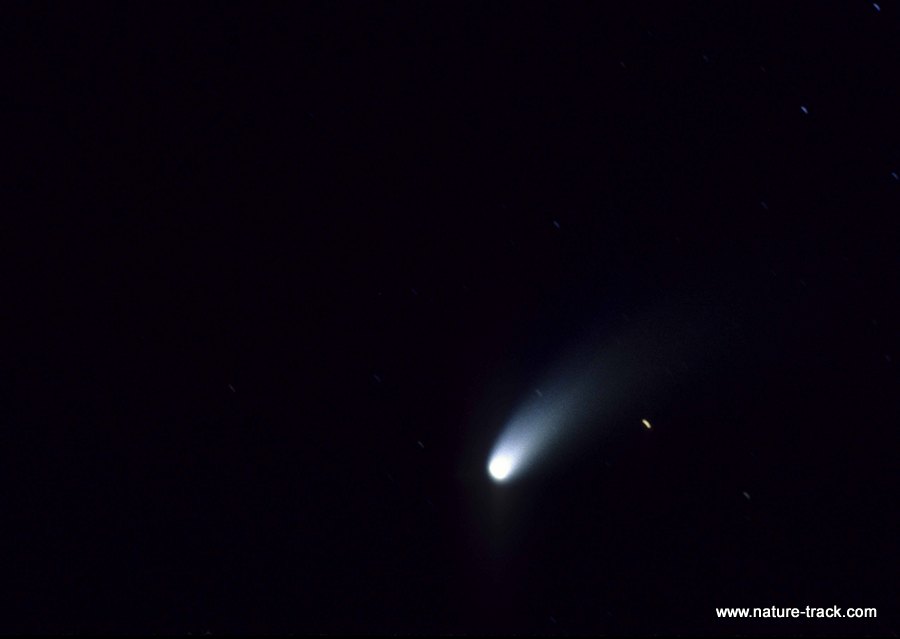Star of Bethlehem

Hale-Bopp Comet photographed in 1997. Could the Star of Bethlehem have been a comet like this one?
Like many folks, I grew up with and have subsequently taught to my children and grandchildren, the Christmas story of the Star of Bethlehem. As the story goes, a new star appeared in the heavens that guided learned men from the East to the Christ child.
However, as we look at the night skies today, we can see about 100 billion stars in the Milky Way Galaxy. What we don’t see is a star that is clearly brighter than the rest, one that points in some way to Bethlehem. Is there a scientific explanation for the star that guided the Magi? Or was it a true miracle or even just a nice, faith bolstering tale?
One advantage of astronomy is predictability. The movement of the stars, planets and even comets is predictable and measurable. For instance, astronomers can calculate exact lunar and solar eclipse times and locations for hundreds of years in advance and can retrace them through history. Computer modeling can do the same thing for the movement of stars and planets.
It should be a relatively easy exercise for brainy astronomers to replay the night skies as they were 2018-2020 years ago (scholars now mostly agree that Jesus was born between 8 and 4 B.C.). As it turns out, there are astronomical events that could potentially fit the description of a new star as told in the Bible. Among the more popular are meteors, comets, the temporary alignment of planets (called a conjunction) that creates a more dominant overlapping or near overlapping light, or even the birth or death of a star.
One theory has been around since at least the 12th century. This theory holds that a conjunction of the planets Jupiter and Saturn occurred three times in 7 B.C. This theory is interesting and persistent but it has more holes than a backcountry road.
Another theory is that a new star literally was born in a spectacular display. Far Eastern astronomers recorded just such an event in 4 B.C. in the constellation Aquila. Visible to the naked eye, this stellar outburst would have been observable in Jerusalem.
A bright comet appeared in the constellation Capricorn in 5 B.C. Calculations indicate that it would have appeared low in the sky and with a tail pointing nearly straight down. Having witnessed the Hale-Bopp Comet in 1997, I could readily see how a comet could be recognized as the Star of Bethlehem.
Finally, a British astronomer calculated that the perceived movement of Jupiter may have been what the Wise Men saw. Because of the rotation of the earth, stars appear to rise in the east and set in the west. However, Jupiter, with its longer orbit, appears to move backward at times, moving west to east, just as the Magi, whom many believe were expert astronomers, claimed.
I certainly am not erudite enough to unravel this mystery. My thinking though is, let the Bible be the Bible, a spiritual guide and not a science lesson. Merry Christmas everyone.

TAX DAY is coming! Here is a chance to do something good with a bit of your tax return and make the day less painful.
Donate part of your tax return to support wildlife in Idaho!
On the second page of the Idaho Individual Tax form 40 you have the opportunity to donate to the “Nongame Wildlife Conservation Fund”.
Check-off this box on your next return or ask your tax preparer to mark the Nongame check-off on your behalf. You can donate any amount you wish, it all helps to support the wildlife you love.
If you are not from Idaho, check with your own state wildlife agency about how you can help. Many states have a similar program.

"WOW. What a phenomenal piece you wrote. You are amazing." Jennifer Jackson
That is embarrassing, but actually a fairly typical response to my nature essays. Since The Best of Nature is created from the very best of 16 years of these nature essays published weekly in the Idaho Falls Post Register (online readership 70,000), it is a fine read. It covers a wide variety of topics including humorous glimpses of nature, philosophy, natural history, and conservation. Readers praise the style, breadth of subject matter and my ability to communicate complex and emotional topics in a relaxed and understandable manner.
Everyone can find something to love in this book. From teenagers to octogenarians, from the coffee shop to the school room, these nature essays are widely read and enjoyed.
Some of the essays here are my personal favorites, others seemed to strike a chord with readers. Most have an important message or lesson that will resonate with you. They are written with a goal to simultaneously entertain and educate about the wonderful workings of nature. Some will make you laugh out loud and others will bring a tear to the eye and warm your heart.
Readers Write:
"You hit a home run with your article on, Big Questions in Nature. It should be required reading for everyone who has lost touch with nature...great job!" Joe Chapman
"We enjoyed your column, Bloom Where Planted. Some of the best writing yet. The Post Register is fortunate to have your weekly columns." Lou Griffin.
To read more and to order a copy, click here or get the Kindle version
Copies are also available at:
Post Register
Island Park Builders Supply (upstairs)
Barnes and Noble in Idaho Falls
Harriman State Park, Island Park
Museum of Idaho
Valley Books, Jackson Wyoming
Avocet Corner Bookstore, Bear River National Wildlife Refuge, Brigham City, Utah
Craters of the Moon National Monument Bookstore, Arco, Idaho